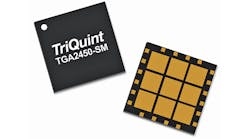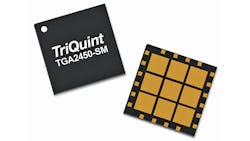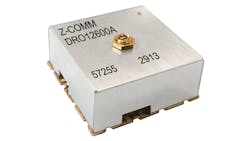RF/microwave amplifier technology continues to break new ground, as components suppliers continue to introduce new products to their amplifier product lines. These new amplifiers include low-noise amplifiers (LNAs) with extremely low noise figures, highly efficient power amplifiers (PAs), and more, each designed for various markets. The markets covered include commercial cellular, defense, satellite-communications (satcom), and others.
Gallium nitride (GaN) semiconductor technology continues to make news, as components suppliers are taking advantage of its benefits to deliver amplifiers reaching new levels of performance. Although the market for GaN is largely defense, opportunities in wireless infrastructure and other markets are growing fast.
TriQuint Semiconductor recently announced its new GaN amplifiers, offering performance, size, and durability advantages for communications, radar, and defense RF systems. In addition, the firm recently announced two new GaN processes.
TriQuint now offers the TQGaN25HV process, which is a high-voltage variant of its original quarter-micron GaN process. This new process extends the drain operating voltage of 0.25-μm GaN transistors to 48 V, while delivering a higher breakdown voltage, greater power density, and high gain for applications from DC to 10 GHz. This enables more rugged devices that can withstand voltage standing wave ratio (VSWR) mismatches, while delivering more RF output power. With its third process, TQGaN15, TriQuint is taking GaN technology to new frequency limits. This new process extends the frequency range of GaN to 40 GHz, while delivering excellent high power density and low-noise performance. The TGA2594 and TGA2595 ground terminal PAs were both created with this new process, providing up to 35 percent power-added efficiency (PAE) in a significantly smaller amplifier size than comparable gallium arsenide (GaAs) solutions.
Among the new portfolio of GaN products is the model TAT9988 MMIC amplifier for cable-television (CATV) and fiber-to-the-home (FTTH) optic networks. The TAT9988 is an industry leader in performance due to its gain, composite distortion, and surface-mount convenience. The TAT9988 exceeds the output linearity performance of traditional GaAs based amplifiers.
TriQuint also unveiled its patented Spatium Technology, which leverages TriQuint’s position as a GaN pioneer and expands its expertise in high power RF solid-state amplifier systems. This technology delivers a higher standard of efficiency, reliability, and frequency range for high-power RF applications, including communications, electronic warfare (EW), and radar. This RF power combining technology replaces traveling-wave-tube amplifiers (TWTAs) in many applications, improving PAE by means of patented coaxial spatial combining techniques. Spatium provides smaller form factors, reduced weight, and higher power densities compared with TWTA based systems or conventional planar power combining products. “TriQuint continues to address our customers’ next generation requirements by delivering innovative high performance RF solutions," explains James L. Klein, Vice President and General Manager for Infrastructure and Defense Products. He adds: "TriQuint innovation is shaping the future for system performance and cost reductions."
New Achievements In LNA Performance
Skyworks Solutions recently unveiled its new portfolio of LNAs, with impressive noise-figure performance. These newest LNAs are ideal for today's 4G wireless infrastructure as well as markets such as Global Positioning System (GPS), broadband, military, and satcom.
Model SKY67151-396LF is a high performance LNA based on GaAs pseudomorphic-high-electron-mobility-transistor (pHEMT) technology. The LNA operates over the frequency range from 0.7 to 3.8 GHz with a noise figure as low as 0.25 dB. "The advanced 0.25 μm GaAs pHEMT enhancement -mode process provides broadband return loss, high gain, very low noise, and high amplifier linearity," explains Stephen Moreschi of Skyworks. The LNA's internal active bias circuitry provides stable performance over temperature and process variation. The SKY67151-396LF is well suited for macro and micro cellular base stations, repeaters, remote radio heads, tower mounted amplifiers, L- and S-Band military communications, GPS receivers, and proprietary radio networks. Skyworks also plans to release new LNAs by November 2013, which will build upon the SKY67151-396LF as some of the most robust LNAs in the industry today, with extended excellent performance down to very low frequencies.
TriQuint also recently introduced two new GaN LNAs, models TGA2611 and TGA2612, which deliver unmatched power handling and low-noise. The TGA2611 operates from 2 to 6 GHz with 25 dB gain and better than 1-dB noise figure, while the TGA2612 operates from 6 to 12 GHz with 25 dB gain and 1.5-dB noise figure. The TGA2611 and TGA2612 both provide +25 dBm output power at 1-dB compression (P1dB).
Small-Cell Market Growth
As the small-cell market segment continues to grow, new products catered to this market have recently been introduced. With small-cell networks being widely deployed by mobile operators all over the world, components suppliers are expanding their line of small-cell based PAs.
TriQuint recently introduced its first integrated PA for small-cell and active antenna base stations. Model TGA2450-SM, which TriQuint calls the industry's most integrated small-cell PA, reduces board space and provides high efficiency, and is the first product in a family serving all of the important mobile infrastructure frequency bands (Fig. 1). The TGA2450-SM provides 2.5 W average output power with an adjacent-channel-power-ratio (ACPR) of -55 dBc from 2.11 to 2.17 GHz. It also has 35 dB gain across its frequency range.
1. The model TGA2450-SM is the industry's most integrated small-cell PA, reducing board space and providing high efficiency. (Photo courtesy of TriQuint.)
Avago Technologies continues to invest in developing new products for the small-cell market segment, with its recent release of two new PAs designed specifically for small-cell base transceiver station (BTS) applications. Models MGA-43728 and MGA-43828, which expand upon the MGA-43x28 product family, both feature high linearity, gain, and PAE. The PAs also have an integrated power detector and shutdown functions. The MGA-43728 provides +27.3 dBm output power with -48 dBc ACPR from 2.62 to 2.69 GHz, while the MGA-43828 provides +27 dBm output power with -50 dBc ACPR from 925 to 960 MHz
Responding to the need to expand network capacity due to the rapid increase of wireless data consumption, ANADIGICS has expanded its family of small-cell PAs with the release of two new models, the AWB7122 and AWB7124. These PAs are optimized for wideband code-division-multiple-access (WCDMA), high speed packet access(HSPA), and LTE small-cell applications, including picocells, enterprise-class femtocells, and high-performance customer premises equipment (CPE). The AWB7122 operates over the frequency range from 1805 to 1880 MHz, while the AWB7124's frequency range is from 728 to 768 MHz. Both the AWB7122 and AWB7124 provide +24.5 dBm of LTE (E-TM1.1) output power with -47 dBc ACPR across their respective frequency ranges.
RF/Microwave Oscillator News And Notes
RF/microwave oscillators have seen recent performance enhancements with the release of several new products. Components suppliers are utilizing their capabilities to deliver oscillators with improved performance at reduced costs. With the need for accurate timing in wireless base stations and other applications, the need for highly accurate performance from oscillators is increasingly important.
Crystek recently released its new model CVSS-945 voltage-controlled crystal oscillator(VCXO). This ultra low-noise sine wave VCXO covers a frequency range from 50 to 125 MHz. It delivers +7 dBm typical output power with exceptional phase noise. In addition, the second harmonic suppression is -25 dBc maximum. According to Ramon Cerda, VP of engineering at Crystek, "The CVSS-945 achieves very low phase noise in a small package at a reasonable cost."
Vectron International recently announced its extended holdover crystal oscillator (EHXO) line, which is a new class of high precision crystal oscillators. The EHXO is specifically designed to ensure accurate timing in wireless base stations at a significantly lower price than rubidium frequency standards. Model MX-042 was developed to meet the increasingly important needs of base stations to maintain accurate frequency and phase as more broadband content is delivered over wireless networks. The MX-042 is capable of achieving performance, which previously was only achieved by expensive rubidium timing standards.
Vectron also recently released model TX-503, which is an ultra-high stability temperature-compensated crystal oscillator (TCXO). Providing a frequency range from 8 to 26 MHz, the TX-503 achieves a stability of ±30 ppb over the extended commercial temperature range of -20 to +70°C by means of Vectron's ultra-smooth compensation algorithms. The TX-503 is designed for small-cell base stations, 1588 packet based timing, portable equipment, military manpack radios, and test equipment.
With a focus on ultra-low noise, low g-sensitivity, and high-temperature precision quartz crystals and blanks, Vectron also recently underwent the expansion of its precision crystal fabrication facility. The recent additions and improvements to the processes and fabrication equipment enable Vectron to produce some of the best aging and ultra low-noise crystals the industry has to offer.
Connor-Winfield recently released its newest oven-controlled crystal oscillator (OCXO), model OX200-SC, which the supplier calls its most quiet, accurate, and stable 10 MHz OCXO. Operating from a +12-VDC supply, the OX200-SC provides a 10-MHz LVCMOS output with low phase noise. Its frequency stability is ±1.5 ppb over the temperature range of 0 to +70°C. The OX200-SC is designed for use in applications that require high frequency stability, tight initial calibration, and low aging.
Fox Electronics also released its FTM series of surface-mount OCXOs, ideally suited as the timing reference for network synchronization. The new FTM series is suitable for base stations, radio network controllers, wireless backhaul equipment, passive-optical-networks (PONs), digital subscriber line access multiplexers (DSLAMs), and multi-service switching platforms. The FTM series provides a standard frequency range from 5 to 40 MHz and a stability of ±10 ppb.
Two new voltage-controlled oscillators (VCOs) were recently announced by Z-Communications for the satcom market. Model V600ME45-LF provides a frequency range from 3 to 6 GHz, while operating from a +12-Vdc supply and drawing only 24 mA. It delivers +6 dBm output power into a 50 ohm load with second-harmonic suppression of better than -12 dBc. Model CRO1320A-LF provides an output at 1320 MHz, while operating from a +5-Vdc supply and drawing only 29 mA. It delivers +3±3 dBm into a 50 ohm load with second-harmonic suppression of better than -18 dBc. The VCOs both operate over the temperature range from -40 to +85°C.
2. Model DRO12600A dielectric resonator VCO is ideal for the test and measurement market. (Photo courtesy of Z-Communications.)
Z-Comm also recently released a new dielectric resonator VCO. Model DRO12600A, designed for the test and measurement market, provides an output at 12.6 GHz, while operating from a +5-VDC supply and drawing 23 mA (Fig. 2). It delivers 0±3 dBm output power into a 50-Ω load with second-harmonic suppression of better than -20 dBc. This VCO also operates over the temperature range from -40 to +85°C.


